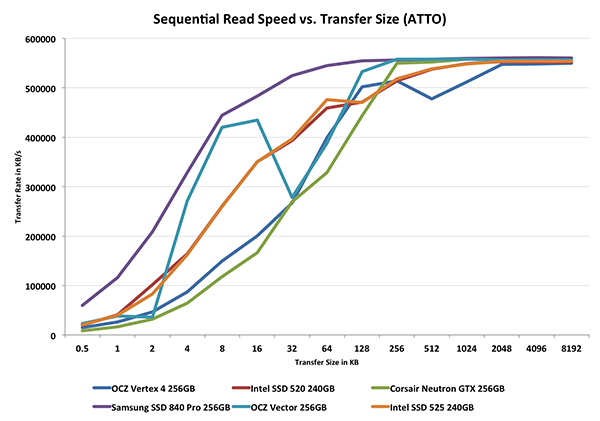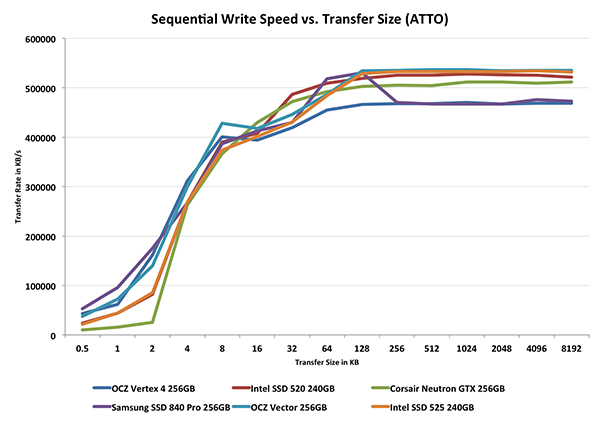Intel SSD 525 Review (240GB)
by Anand Lal Shimpi on January 30, 2013 1:42 AM ESTPerformance vs. Transfer Size
ATTO does a good job of showing us how sequential performance varies with transfer size. Most controllers optimize for commonly seen transfer sizes and neglect the rest. The optimization around 4KB, 8KB and 128KB transfers makes sense given that's what most workloads are bound by, but it's always important to understand how a drive performs across the entire gamut.
The 525's sequential read curve is almost identical to that of the 520. Whatever firmware improvements exist in the 525, they don't seem to obviously impact low queue depth sequential read performance over the 520.
Sequential write performance is a similar story, although the 520 does have a bit of an advantage in 32KB sequential transfers. Overall the 525 and 520 look indistinguishable however.












21 Comments
View All Comments
philipma1957 - Wednesday, January 30, 2013 - link
meaker10 have you used a msi gt60?critical_ - Wednesday, January 30, 2013 - link
I'm using Startech's SAT2MSAT25. It is a "passthrough" design so it'll work at 6Gbps is your controller supports it.HyperJuni - Wednesday, January 30, 2013 - link
I was hoping for a comparison with the m4/C400 mSATA 256GB, since it seems to differ a bit in performance from the 128GB model, and would be better suited as a "direct competitor" to the 240GB 525 for the same of comparison IMHO.Too bad you didn't include it in the charts, Anand.
nathanddrews - Wednesday, January 30, 2013 - link
Since IOPS consistency improves significantly when setting aside 25% spare area, what is the practical effect in real world? Has this been documented using the AT Storage Bench? Under default conditions, the 840 Pro dominates the top of the charts, but does it still retain the crown after being "stroked"? Just curious...SanX - Wednesday, January 30, 2013 - link
Is it burning hot for its size? Will it fry your eggs?SanX - Wednesday, January 30, 2013 - link
damn cellphone spell-correction typo and lack of edit option like on cheap websites: ***incompressible***dealcorn - Wednesday, January 30, 2013 - link
The prospect of the S3700 technology in a consumer drive has appeal except that the S3700 uses too much power. Is Intel's approach inherently inefficient or is it reasonable that Intel can tune the technology differently for the consumer market to achieve competitive efficiency?name99 - Wednesday, January 30, 2013 - link
"Why does Intel continue to use a third party SATA controller in many of its flagship drives? Although I once believed this was an issue with Intel having issues on the design front, I now believe that a big part of it has to do with the Intel SSD group being more resource constrained than other groups within the company.
"
This seems strangely short sighted. How is flash controlled on mobile devices?
Obviously performance is substantially lower. It's not clear to me how that lowering is split between
- cheaper, lower-end flash
- only one rank (or whatever flash their call their equivalent), ie limited parallelism
- a dumb controller.
However there doesn't seem to be any aspect of the problem that is inherently power limited.
Which implies that if Intel wanted a way to make their perpetually lagging Atom SOCs a little more noteworthy, one way to do so would be to work on them having flash support that was substantially faster than what's available on ARM today.
emvonline - Thursday, January 31, 2013 - link
Sandforce controllers are high performance, have no DRAM need, and allow both SF standard and custom firmware. Until SF drops the ball on performance or support I would look for more SSDs to be based on the SF design, not less. Enterprise is different ball game where ASPs/margins are much higher so custom controller might make sense (volumes are much lower though). If other 3rd party controllers mature, I expect them to gain market share as well.damnintel - Wednesday, March 13, 2013 - link
heyyyy check this out damnintel dot com